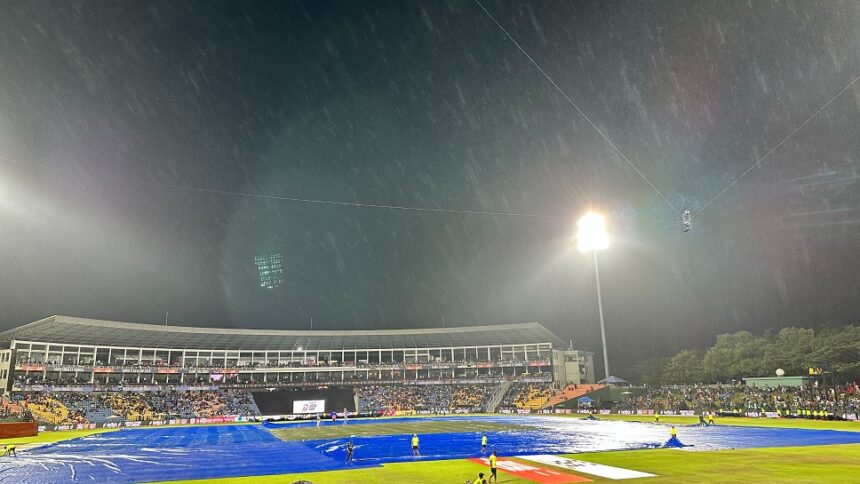The much-awaited India vs Pakistan clash in the Asia Cup 2023 has lived up to its hype so far. However, rain threatens to play spoilsport in the Group A encounter being played at the Pallekele International Stadium in Kandy, Sri Lanka. India batted first after winning the toss and posted 266/10 in 48.5 overs before rain stopped play. With the possibility of overs being reduced in Pakistan’s chase, the Duckworth-Lewis-Stern (DLS) method will come into the picture to recalculate the target. This presents an intriguing scenario as the revised DLS target could tilt the match in either team’s favor.
Why is DLS Important in India vs Pakistan Today Match?
The DLS method, used in limited overs cricket, resets targets in rain-affected matches based on resources available to both teams. With rain already interrupting play during India’s innings and more showers predicted, overs are likely to be reduced in Pakistan’s chase. This makes DLS paramount in deciding a winner if Pakistan’s target is revised downwards. A lower target could aid Pakistan’s bid to overhaul India’s 266. Alternatively, if overs are significantly cut, India could benefit too.
How Does DLS Work to Calculate Revised Targets?
The DLS system uses a complex mathematical formula taking into account balls remaining, wickets in hand and the projected score of the team batting first. It aims to calculate revised targets to equalize opportunities for both sides. Factors like phase of innings when interruption happened are also considered. Essentially, DLS tries to quantify remaining resources and project the eventual total. This forms the basis for calculating par scores.
What Will Be Pakistan’s Duckworth Lewis (DLS) Targets at Reduced Overs in Asia Cup 2023?
If Pakistan’s innings is reduced to:
- 45 overs: Target – 254
- 40 overs: Target – 239
- 36 overs: Target – 226
- 30 overs: Target – 203
- 25 overs: Target – 184
- 20 overs: Target – 155
As seen above, the target drops substantially as overs are reduced. The required run rate also falls, benefiting the chasing team.
If overs are reduced, Pakistan's target will be:
— Mazher Arshad (@MazherArshad) September 2, 2023
254 if 45 overs
239 if 40 overs
203 if 30 overs
155 if 20 overs
As per Latest Updates, Ind vs Pak Asia Cup match has been called off due to rain.
India Vs Pakistan called off due to rain! pic.twitter.com/6ZC7tzJoJp
— Mufaddal Vohra (@mufaddal_vohra) September 2, 2023
Does the Pitch and Conditions Impact Duckworth Lewis Calculations?
Yes, the nature of the pitch and conditions is also accounted for in the DLS method. The projected totals factor in the scoring patterns and rates seen in the first innings. For example, Pallekele has favored bowling so far, with pacers enjoying swing and seam movement. This will be considered when revising Pakistan’s target if overs are curtailed.
When Does DLS Come Into Play?
For DLS to apply, the minimum overs required for a result need to be complete. In ODIs, each team needs to face 20 overs. So if overs are reduced to below 20 per side, DLS cannot apply and the match is abandoned. Once the minimum is crossed, DLS target will be calculated if required.
Will Toss & Batting First Give India an Advantage Under DLS?
Not necessarily. It depends on when the interruption occurs. If early in Pakistan’s chase, India benefits. However, if after the halfway mark, Pakistan could gain from DLS revision as targets get substantially lowered. Overall, batting first is an advantage but Pakistan can also exploit in their favor if overs are cut later in their innings.
Does the Opening Onslaught Give Pakistan an Edge in Chasing?
Pakistan openers Babar Azam and Mohammad Rizwan have a phenomenal record in T20I chases. Their ability to get off to flying starts could be a key factor if DLS comes into play. However, India also has a power-packed top order. So both teams are evenly poised in this department. How Pakistan starts its innings and if they keep wickets in hand will be crucial if chasing a revised DLS target.
What is India’s Best Chance of Victory if Overs Are Reduced?
India’s best bet remains keeping Pakistan to the lowest score possible. Their pacers need to strike early blows and apply sustained pressure. If they can restrict Pakistan to around 110-120/4 after 20-25 overs, India will be in a good position even if overs are significantly cut later on. A lot depends on how Shaheen Afridi and the Pakistani fast bowlers start with the new ball.
Does the Toss Decision to Bat First Backfire for India Under DLS?
No, not really. India would have been aware of DLS ramifications before deciding to bat. Their sizable total gives them a competitive advantage. Even with overs reduced later, India can be satisfied with 266 on the board. Batting first also allowed them to play full quota of overs. So India can still control the match if their bowlers strike early in Pakistan’s chase.
Will We Get a Result if More Overs Are Lost?
It depends on how many overs are ultimately left for each team before rain forces abandonment. The minimum 20 overs per team is needed for a DLS-based result. Unfortunately, more rain could leave us without a winner in this high-voltage clash. For fans’ sake, fingers will be crossed for the weather to clear up and allow a full DLS chase.
India vs Pakistan Asia Cup 2023 Latest Update & News
Latest Updated News 09:52 Pm (IST):
India Vs Pakistan called off due to rain!
Previous News:
Due to persistent rain interruptions during the India-Pakistan Asia Cup match, the number of overs for Pakistan’s innings has been reduced, raising the question of how many runs Pakistan needs to score within these reduced overs to secure a victory against India.
The India-Pakistan match in the Asia Cup faced three rain interruptions, twice during India’s innings and once after it concluded. Consequently, the stipulated time for commencing the second innings has expired, resulting in a reduction in the number of overs Pakistan will have for their batting innings. We now know how many overs Pakistan must bowl to emerge victorious.
India batted first, managing to score 266 runs before getting all out in 48.5 overs. Should Pakistan be allotted 36 overs, they would need to chase down 226 runs for victory. In the event that the overs are further reduced to 30, the target for Pakistan, led by Babar Azam, becomes 203 runs for a win. Finally, should the game be limited to 20 overs, Pakistan must aim for 155 runs. It’s essential for Pakistan to complete at least 20 overs to have a chance at victory.
Pakistan need 226 in 36 overs to defeat India. pic.twitter.com/E2C5Ln65s3
— Mufaddal Vohra (@mufaddal_vohra) September 2, 2023
As per latest updates from Mufaddal Vohra, “The cut-off time for a 20 overs run chase is 10.27pm.”
From the outset, the India-Pakistan match was under the threat of rain. Nevertheless, Indian captain Rohit Sharma won the toss and elected to bat first. Rain commenced during the fifth over of the match, resulting in the first stoppage. Subsequently, India’s innings experienced another interruption due to rain. After India concluded their innings at 266, rain made a third appearance, causing a temporary halt to proceedings.
Conclusion
In essence, this India vs Pakistan contest has become a lottery with weather and DLS being unpredictable factors. Much will hinge on when interruptions happen and if any more overs are lost. While India is currently ahead having posted 266, the scales could tilt if Pakistan gets to chase a reduced target under DLS calculations. With Arch-rivals clashing at a neutral venue, the tense chase promises further thrills and spills before the DLS-weather lottery produces a winner!
In summary, the recurring rain threat adds another layer of complexity to the crucial India-Pakistan Asia Cup face-off. If overs are reduced in Pakistan’s chase, the ever-important DLS method will kick in to recalculate the target. This presents a tricky scenario as a revised par score could assist either team depending on when interruptions occur. How Pakistan starts its abbreviated chase and if India’s bowlers can strike early will be vital in this DLS-weather lottery. Hopefully, the rain relents to allow a full contest that this high-profile matchup deserves.
Frequently Asked Questions (FAQs)
1. What is the DLS method in cricket?
DLS or Duckworth-Lewis-Stern is a mathematical model used in limited overs cricket to reset targets in matches affected by interruptions like rain. It aims to calculate fair revised targets based on resources available.
2. How is the DLS target calculated?
The DLS method considers factors like balls left, wickets in hand, projected first innings score etc. to quantify remaining resources and revise targets so both teams get equal opportunities.
3. What will be Pakistan’s DLS target if 20 overs are left?
If Pakistan’s innings is reduced to 20 overs, their DLS revised target would be 155 runs as per current projections.



































